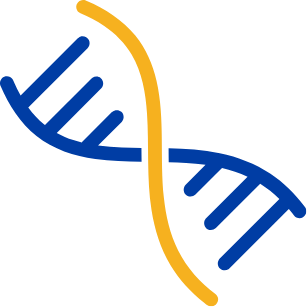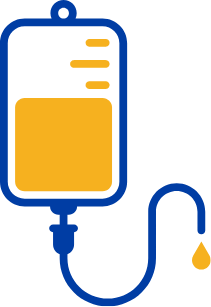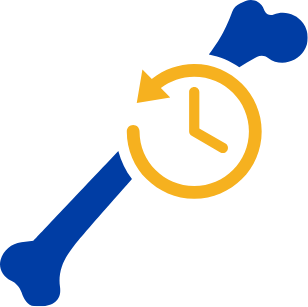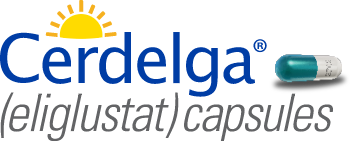Observational, retrospective, 20‑year study: Evaluation of risk factors for osteonecrosis in
patients receiving treatment for Gaucher disease type 1 (GD1)1
Understanding the risk of osteonecrosis (also known as avascular necrosis, or AVN) is crucial when managing GD1. Osteonecrosis is one of the most debilitating, severe, and irreversible manifestations of GD1, and any patient with GD1 is at risk, even when receiving treatment.1,2
This 20-year, observational, retrospective study evaluated certain risk factors contributing to osteonecrosis in patients receiving therapy.1
Patients with GD1 may be at increased risk for osteonecrosis if they have1

Heteroallelic p.N409S
GBA1 genotype

Increased residual glucosylsphingosine
(lyso-GL-1) levels after starting treatment

Treatment history with a specific ERT

History of osteonecrosis prior to initiation of treatment
About osteonecrosis
GD1 causes cellular accumulation of glucosylceramide and lyso-GL-1, leading to complex bone diseases, including osteonecrosis1
Osteonecrosis refers to the death of bone tissue, which may be caused by a lack of blood supply1
Osteonecrosis from GD1 is devastating and irreversible, causing2
- Pain
- Chronic disability
- Need for orthopedic surgeries
- Reduced quality of life
The underlying mechanism(s) of osteonecrosis in Gaucher disease is not fully understood1
94% of patients with GD1 have evidence of bone disease, including osteonecrosis, which can manifest at all ages.2,3
Patients with GD1 are at risk for osteonecrosis, even while on treatment1


Observational, retrospective, 20-year study: Study design

- Retrospective, observational, single‑center study of 155 patients with GD1 followed longitudinally for 20 years
- Patients were followed every 1 to 2 years with standard-of-care evaluations, including magnetic resonance imaging (MRI) to assess organomegaly and bone marrow infiltration, and laboratory testing
- Serum samples were collected at each clinic visit to determine biomarker trends for lyso-GL-1 and chitotriosidase (chito), as well as other indicators of disease
- During the observational period, patients received a total of 834 treatment years for imiglucerase (ERT), 310 treatment years for velaglucerase alfa (ERT), and 238 treatment years for Cerdelga (SRT)

- Confirmed diagnosis of GD1
- Known treatment status and date of initiation/switch
- Known splenectomy status
- Known previous history of osteonecrosis
- Longitudinal data of MRI volumetrics for liver and spleen, cell blood count (CBC), and biomarkers including lyso-GL-1 and chito

- This is a single-center study. It was also retrospective and observational. This study was not a randomized, controlled study
- Tertiary referral center: The incidences of osteonecrosis reported in this study may or may not be reflective of the incidence that would be observed in other clinics, particularly ones that are not tertiary referral centers for Gaucher disease
- The treatment and management decisions reported were directed by the clinical judgment of the treatment team at this single center. Treatment decisions for each patient are due to a number of different factors, including but not limited to the patient’s clinical status and availability of each therapy option
No patients taking Cerdelga experienced osteonecrosis in this observational, 20-year study1

- Osteonecrosis episodes were counted per total number of years on each type of treatment; over this 20-year period, some patients may have switched from one treatment to another
- During the 20-year span of this study, there were 16 episodes of osteonecrosis in 14 patients, with 2 episodes each occurring in 2 patients
For Cerdelga and velaglucerase alfa, data are only available starting from 2014 and 2010, respectively, when they were approved by the FDA.4,5
For more information about this data and the study, see the article in eLife.
Generally, episodes of osteonecrosis were associated with new, exacerbated, or chronic bone pain that prompted new visits earlier than regularly scheduled 1- to 2-year follow‑ups.1
Occasionally, new osteonecrosis was found on MRI scans taken at regularly scheduled follow-up visits. On closer evaluation, patients reported bone pain they had managed independently.1
How treatment impacted GD-1–associated biomarkers over 20 years1

Normal healthy control levels of lyso-GL-1 were ≤1 ng/mL.1
Patients with high levels of residual lyso‑GL-1* had an increased risk for osteonecrosis in this observational study1,6

CHIT1 genotyping was performed to normalize serum levels.1
There was no observed association between levels of residual chito and the risk of osteonecrosis in this group of patients1
This study was observational and not designed to compare the outcomes of treatment or draw conclusions on the effect of one treatment over another.1
During this 20-year period, some patients may have switched treatments.1
*Residual lyso-GL-1 refers to serum concentration measured in a sample taken at close proximity to the onset of osteonecrosis (but not levels prior to treatment initiation).1
Findings: The 4 risk factors for osteonecrosis in patients with GD11

Heteroallelic p.N409S GBA1 genotype
Heteroallelic N409S GD1 patients were 10 times more likely than N409S homozygous GD1 patients to develop osteonecrosis during treatment1

Increased residual lyso-GL-1 levels after starting treatment
A higher residual serum lyso‑GL-1* was correlated with an increased risk of developing osteonecrosis during treatment1

Treatment history with a specific ERT
Patients received cumulative 310 treatment years velaglucerase and there were 10 episodes of osteonecrosis, which is 3.2 episodes per 100 treatment years of velaglucerase1

History of osteonecrosis prior to initiation of treatment
Patients had a 4.8 times higher risk for osteonecrosis while receiving treatment if they had a history of osteonecrosis prior to treatment initiation1
*Residual lyso-GL-1 refers to serum concentration measured in a sample taken at close proximity to the onset of osteonecrosis (but not prior to treatment initiation).1
Curious how Cerdelga impacted other bone health parameters in patients with GD1?
Explore clinical trial results for bone marrow burden, bone mineral density, and bone pain for patients with GD1
Indication and Usage
CERDELGA is indicated for the long-term treatment of adult patients with Gaucher disease type 1 (GD1) who are CYP2D6 extensive metabolizers (EMs), intermediate metabolizers (IMs), or poor metabolizers (PMs) as detected by an FDA-cleared test.
Limitations of Use:
- Patients who are CYP2D6 ultra-rapid metabolizers (URMs) may not achieve adequate concentrations of CERDELGA to achieve a therapeutic effect.
- A specific dosage cannot be recommended for those patients whose CYP2D6 genotype cannot be determined (indeterminate metabolizers).
Important Safety Information
CONTRAINDICATIONS
CERDELGA is contraindicated in the following patients based on CYP2D6 metabolizer status due to the risk of cardiac arrhythmias from prolongation of the PR, QTc, and/or QRS cardiac intervals:
- Extensive Metabolizers (EMs) taking a strong or moderate CYP2D6 inhibitor concomitantly with a strong or moderate CYP3A inhibitor, EMs with moderate or severe hepatic impairment, or EMs with mild hepatic impairment and taking a strong or moderate CYP2D6 inhibitor.
- Intermediate Metabolizers (IMs) taking a strong or moderate CYP2D6 inhibitor concomitantly with a strong or moderate CYP3A inhibitor, IMs taking a strong CYP3A inhibitor, or IMs with any degree of hepatic impairment.
- Poor Metabolizers (PMs) taking a strong CYP3A inhibitor, or PMs with any degree of hepatic impairment.
WARNINGS AND PRECAUTIONS
CERDELGA is predicted to cause increases in ECG intervals (PR, QTc, and QRS) at substantially elevated plasma concentrations and may increase risk of cardiac arrhythmias. Use of CERDELGA is contraindicated, to be avoided, or requires dosage adjustment in patients taking CYP2D6 or CYP3A inhibitors, depending on CYP2D6 metabolizer status, type of inhibitor, or degree of hepatic impairment. Avoid use of CERDELGA in patients with pre-existing cardiac disease, long QT syndrome, or in combination with Class IA or Class III antiarrhythmic medications.
ADVERSE REACTIONS
The most common adverse reactions (≥10%) to CERDELGA include: fatigue, headache, nausea, diarrhea, back pain, pain in extremities, and upper abdominal pain.
DRUG INTERACTIONS
Coadministration of CERDELGA with CYP2D6 or CYP3A inhibitors may increase eliglustat concentrations, which may increase the risk of cardiac arrhythmias from prolongations of the PR, QTc, and/or QRS cardiac interval. Use of CERDELGA is contraindicated, to be avoided, or may require dosage adjustment depending on the concomitant drug and CYP2D6 metabolizer status. See section 7 of the full Prescribing Information for more details and other potentially significant drug interactions.
USE IN SPECIFIC POPULATIONS
Available data on the use of CERDELGA in pregnant women is not sufficient to assess drug-associated risks of major birth defects, miscarriage, or adverse maternal or fetal outcomes. The developmental and health benefits of breastfeeding should be considered along with the mother’s clinical need for CERDELGA and any potential adverse effects on the breastfed child from CERDELGA or from the underlying maternal condition.
Use of CERDELGA in patients with renal impairment is based on the patient’s CYP2D6 metabolizer status. Avoid use of CERDELGA in EMs with end-stage renal disease (ESRD), and IMs and PMs with any degree of renal impairment.
Use of CERDELGA is contraindicated or may require dosage adjustment in patients with hepatic impairment based on CYP2D6 metabolizer status, concomitant use of CYP2D6 or CYP3A inhibitors, and degree of hepatic impairment.
Please see accompanying full Prescribing Information.
References: 1. Basiri M, Ghaffari ME, Ruan J, et al. Osteonecrosis in Gaucher disease in the era of multiple therapies: biomarker set for risk stratification from a tertiary referral center. Elife. 2023;12:e87537. 2. Hughes D, Mikosch P, Belmatoug N, et al. Gaucher disease in bone: from pathophysiology to practice. J Bone Miner Res. 2019;34(6):996-1013. 3. Charrow J, Andersson HC, Kaplan P, et al. The Gaucher registry: demographics and disease characteristics of 1698 patients with Gaucher disease. Arch Intern Med. 2000;160(18):2835-2843. 4. CERDELGA (eliglustat) [prescribing information]. Genzyme Corporation, Cambridge, MA. 5. VPRIV (velaglucerase alfa) [prescribing information]. Takeda Pharmaceuticals, Lexington, MA. 6. Murugesan V, Chuang WL, Liu J, et al. Glucosylsphingosine is a key biomarker of Gaucher disease. Am J Hematol. 2016;91(11):1082‑1089.
Indication and Usage
CERDELGA is indicated for the long-term treatment of adult patients with Gaucher disease type 1 (GD1) who are CYP2D6 extensive metabolizers (EMs), intermediate metabolizers (IMs), or poor metabolizers (PMs) as detected by an FDA-cleared test.
Limitations of Use:
- Patients who are CYP2D6 ultra-rapid metabolizers (URMs) may not achieve adequate concentrations of CERDELGA to achieve a therapeutic effect.
- A specific dosage cannot be recommended for those patients whose CYP2D6 genotype cannot be determined (indeterminate metabolizers).
Important Safety Information
CONTRAINDICATIONS
CERDELGA is contraindicated in the following patients based on CYP2D6 metabolizer status due to the risk of cardiac arrhythmias from prolongation of the PR, QTc, and/or QRS cardiac intervals:
- Extensive Metabolizers (EMs) taking a strong or moderate CYP2D6 inhibitor concomitantly with a strong or moderate CYP3A inhibitor, EMs with moderate or severe hepatic impairment, or EMs with mild hepatic impairment and taking a strong or moderate CYP2D6 inhibitor.
- Intermediate Metabolizers (IMs) taking a strong or moderate CYP2D6 inhibitor concomitantly with a strong or moderate CYP3A inhibitor, IMs taking a strong CYP3A inhibitor, or IMs with any degree of hepatic impairment.
- Poor Metabolizers (PMs) taking a strong CYP3A inhibitor, or PMs with any degree of hepatic impairment.
WARNINGS AND PRECAUTIONS
CERDELGA is predicted to cause increases in ECG intervals (PR, QTc, and QRS) at substantially elevated plasma concentrations and may increase risk of cardiac arrhythmias. Use of CERDELGA is contraindicated, to be avoided, or requires dosage adjustment in patients taking CYP2D6 or CYP3A inhibitors, depending on CYP2D6 metabolizer status, type of inhibitor, or degree of hepatic impairment. Avoid use of CERDELGA in patients with pre-existing cardiac disease, long QT syndrome, or in combination with Class IA or Class III antiarrhythmic medications.
ADVERSE REACTIONS
The most common adverse reactions (≥10%) to CERDELGA include: fatigue, headache, nausea, diarrhea, back pain, pain in extremities, and upper abdominal pain.
DRUG INTERACTIONS
Coadministration of CERDELGA with CYP2D6 or CYP3A inhibitors may increase eliglustat concentrations, which may increase the risk of cardiac arrhythmias from prolongations of the PR, QTc, and/or QRS cardiac interval. Use of CERDELGA is contraindicated, to be avoided, or may require dosage adjustment depending on the concomitant drug and CYP2D6 metabolizer status. See section 7 of the full Prescribing Information for more details and other potentially significant drug interactions.
USE IN SPECIFIC POPULATIONS
Available data on the use of CERDELGA in pregnant women is not sufficient to assess drug-associated risks of major birth defects, miscarriage, or adverse maternal or fetal outcomes. The developmental and health benefits of breastfeeding should be considered along with the mother’s clinical need for CERDELGA and any potential adverse effects on the breastfed child from CERDELGA or from the underlying maternal condition.
Use of CERDELGA in patients with renal impairment is based on the patient’s CYP2D6 metabolizer status. Avoid use of CERDELGA in EMs with end-stage renal disease (ESRD), and IMs and PMs with any degree of renal impairment.
Use of CERDELGA is contraindicated or may require dosage adjustment in patients with hepatic impairment based on CYP2D6 metabolizer status, concomitant use of CYP2D6 or CYP3A inhibitors, and degree of hepatic impairment.
Please see accompanying full Prescribing Information.
References: 1. Basiri M, Ghaffari ME, Ruan J, et al. Osteonecrosis in Gaucher disease in the era of multiple therapies: biomarker set for risk stratification from a tertiary referral center. Elife. 2023;12:e87537. 2. Hughes D, Mikosch P, Belmatoug N, et al. Gaucher disease in bone: from pathophysiology to practice. J Bone Miner Res. 2019;34(6):996-1013. 3. Charrow J, Andersson HC, Kaplan P, et al. The Gaucher registry: demographics and disease characteristics of 1698 patients with Gaucher disease. Arch Intern Med. 2000;160(18):2835-2843. 4. CERDELGA (eliglustat) [prescribing information]. Genzyme Corporation, Cambridge, MA. 5. VPRIV (velaglucerase alfa) [prescribing information]. Takeda Pharmaceuticals, Lexington, MA. 6. Murugesan V, Chuang WL, Liu J, et al. Glucosylsphingosine is a key biomarker of Gaucher disease. Am J Hematol. 2016;91(11):1082‑1089.



